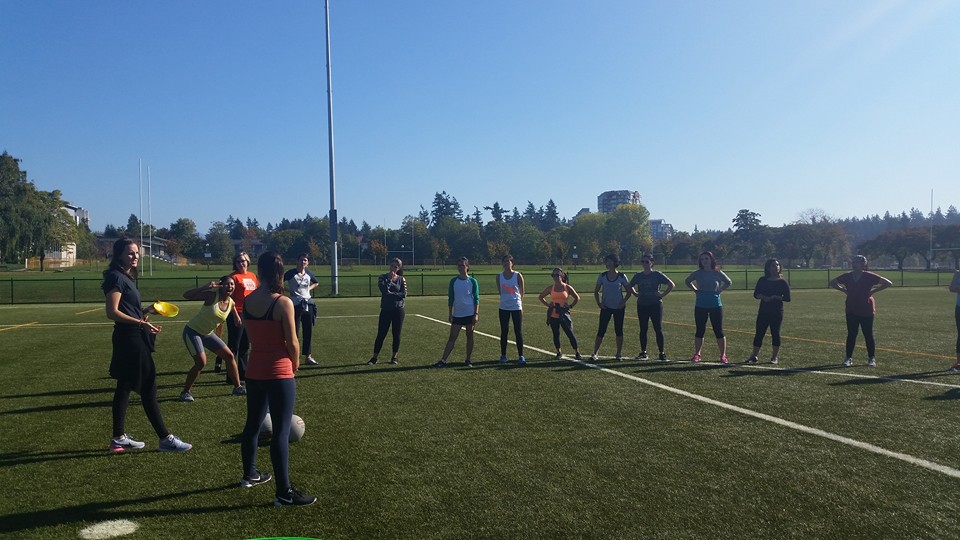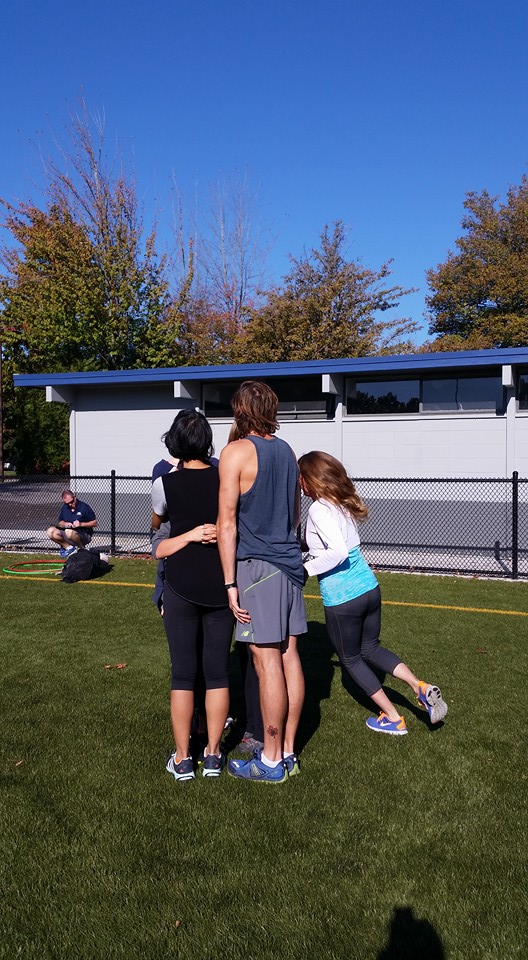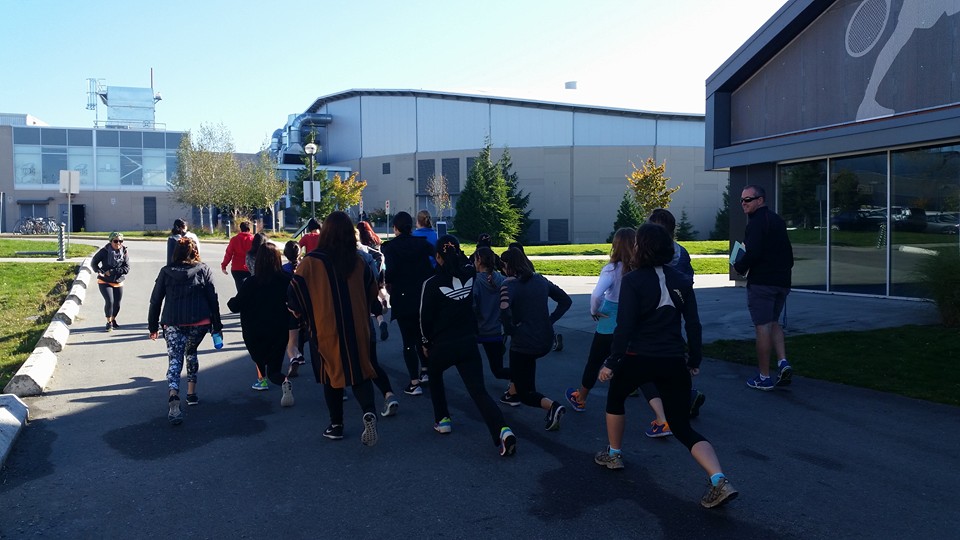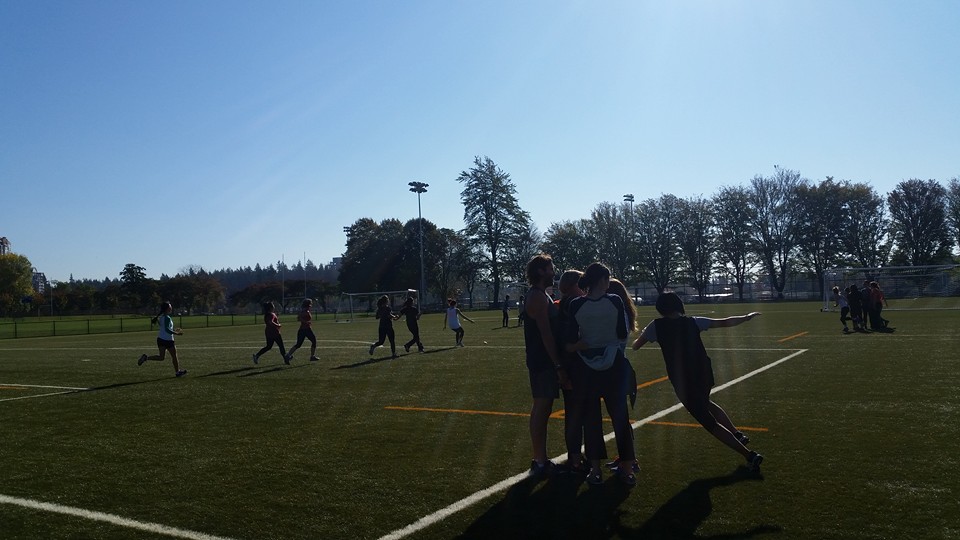Striking/Fielding Reflection
- The thing that worked well in our lesson is that everything was connected. We had an idea that we wanted to teach skills for baseball and all of our activities were connected to that. For our Incoming game, we had the student’s practice working as a team, throwing, catching and pretending to run to home when they were done. They were able to transfer those skills into the main striking game. I contributed by coming up with the main activity, and finding ways to modify other activities so everyone was included. I think our group worked very well together and everyone pulled their weight.
- I noticed about planning and teaching that there are many areas you have to consider when planning a lesson- does the lesson flow and does it have a purpose, is everyone included, are any of the games shaming games, is it safe for the children and how much time should you allocate for each activity. Since one of our chapters was about assessment, everyone in class was able to give feedback on what worked. We had to modify our last game to make it safer since some people slipped on the mats and people were running into each other. I think this was good because it helped us see what worked and students were able to come up with suggestions on how to improve it.
- I noticed that all of the students were participating and seemed to have fun so that helped with the lesson. I’m glad we had activities that included everyone because you really got to see the skills everyone had and you did not need to be super athletic to participate in our games.
- The things that I would do differently are pay closer attention to the safety of the children. I would have used softer balls and had them touch the mat with their hands or tap it with their toes instead of running on it. Also, some of my instructions needed to be clearer because some students were a little confused and the passing game would have been good to do twice since after one round everyone knew what to do. I think over all I learned that teaching a physical education class is very different than other lessons I have done because of the size of the gym and there’s more distractions for children. You need to find a balance to lead the class but also participate with them.
Striking/Fielding Lesson Plan
Pamela Tai
Emily Mills
Sonya Gaia-Maretta
Lesson Plan: Striking/Fielding
Class: Grade 2
Objective:
The objective is to teach students where to hit a ball, how to cover the field and how to field ground balls. In addition, students build on their previous knowledge of baseball and begin to visually conceptualize how a formal game of baseball is played. Students will also be able to gain confidence and interpersonal skills by working in small groups and playing with the class in an inclusive and non-competitive environment.
PLO:
B4 demonstrate proper technique for performing specific manipulative movement skills including but not limited to the following: one-handed throw underhand two-handed catch without trapping against body
C1 demonstrate safe behaviours when participating in physical activity (e.g., listening to and following directions, staying within activity boundaries, participating in appropriate warm-up activities, making sure the activity space is free of obstacles)
Equipment Required:
- Mats (enough for each fielder)
- Ball (small- one that bounces tennis ball)
- Soft kicking ball
- Hula hoops
- Cones (small)
Safety: mats are too slippery, tennis balls may be too hard (move to softer ball)
Entry Activity:
Musical Hula-hoops: (5 minutes- Pamela will lead)
This is a warm up activity for a grade 2 PE class. Each student grabs a hula-hoop and places it on the ground to form part of a big circle. The teacher plays music and asks the students to dance outside the circle formed by the hula-hoops (with instructions such as dance like a bird, dance like a bunny). After each round, the teacher will remove 5 hula-hoops. Students need to step into one hula-hoop when the music ends. Students may share the hula-hoops when the music ends. We will start with one person per each hoop then go down to 5-6 people per hoop. To meet the needs of the student we will clarify if they understand by asking them. During the activity, we can look for the overall engagement of the students and how well they seem to be interacting with each other.
Skill Development and Practice:
In- Coming: (10 minutes- Pamela will lead and Sonya and Emily will demonstrate)
Divide the class into six groups. Each group will have a hula-hoop in the corner of the gym. In the middle of the gym are a bunch of balls. When the teacher says go, one person from each group will grab a ball from the middle of the gym and throw it down to each player and the last player will put the ball in the hula-hoop. (students cannot form one line and pass, they should be diagonal from each other). That person will then run to the front of the line and grab a ball and throw it down the line. Each player on your team has to have a chance to be it. The first team to get all of their balls in the hula- hoop wins. This allows your students to practice throwing while working as a team. This prepares them for the next activity by using teamwork, throwing and running skills.
Culminating Activity:
Striking Game: (15 minutes- Sonya will lead and Pamela and Emily will demonstrate)
This is a game that all students participate. There are three parts to this game. First, you will have fielders who each have a mat in the open gym and then you have the batters who are standing against a wall with a ball. When the music starts the batters throw their ball and try to touch every base with their hand while the fielders collect the ball and run to the wall. When the music stops it means every fielder got a ball and the batter has to quickly find a mat. When that is done each team switches. Now the fielders are the batters and the batters are the fielders. Next, instead of the batters throwing the ball they have to bounce the ball and then run to each base. When that is done you can switch. The final is kicking a ball. In this exercise batters are practicing how to run to different bases and the fielders get to practice catching balls in the air, catching them while they are bouncing or rolling on the ground. During the game, we will watch for how strong students are able to throw the ball and their ability to navigate and run to different bases.
Closure:
Yoga: (5 minutes- Emily will lead)
Stretching exercises to cool down their body. Ask students how they felt about the activity and reflect on different strategies that they learned.
Meeting the needs of diverse learners
Physical: use music and rhythm skills, develop specialized skills (throwing, catching and bouncing)
Cognitive: have games that everyone can participate in, allow students to be creative in their animal choices. Be able to have an abstract conception of how baseball is structured (batters and fielders).
Affective: Use entire group sparingly and allow every student to feel included in the activities. Play in smaller groups initially to increase teamwork and play in a non-competitive larger class game which allows students to develop baseball skills without comparing themselves to others.
Modifying/adapting lesson:
Students are able to run at their own pace. It is not a competition on how many bases you can get. If students find that the little tennis balls are too hard to throw we can move to bigger balls.
Evaluation Strategies:
Observation-observe students level of engagement and confidence, cooperation in small groups and the ability to throw and run bases as they’re performing the activities
.Self-Reflection-ask the students about their general knowledge of baseball (ie. batters and fielders) as well as reflect on the strategies they learned during the activities. Receive students feedback about how the activities went and engage them in the learning process.
Assessment tool: (Source: http://www.sparkpe.org/wp-content/uploads/2009/11/K2_CaT_Rubric.pdf)
| Moving and Doing | Understanding and Applying | Cooperation and Responsibility |
| Participates in a variety of activities
□ comes prepared to participate □ wears appropriate clothing for the activity □ is ready and on time □ gets involved in activities □ is active |
Understands and has the ability to pose and solve movement challenges
□ understands the task □ can demonstrate the task (individually and with others) □ helps other students |
Demonstrates cooperative and socially responsible behaviors
□ cares for the safety of others □ respects personal and public property □ respects others □ encourages appropriate behavior |
| Applies body mechanics in movement activities
□ Applies developmentally appropriate technique for activities e.g.,hand eye coordination (throwing and catching) |
Understands and applies game and movement concepts
□ understands the instructions □ follows instruction □ uses skills and ideas taught in activities |
Demonstrates personal responsibility
□ shows care for personal safety □ cares for personal health and hygiene □ respects self |
| Engaged in movement, motor and athletic skill development activities
□ uses movement and athletic skill in a variety of activities □ tries to the best of his/her abilities in activities □ is on task □ works on skill development |
Understands and applies group dynamics and concepts of fair play
□ contributes to the group □ is a team player □ practices fair play □ practices sportsmanship |
Demonstrates leadership and group dynamic skills
□ work with and include others during activity □ consider the views of others during games and play □ lead by positive example □ value the contributions of all |
| Engages in personal fitness activities
□ participants in personal fitness activities □ works to remain physically active □ works on his/her health related fitness (cardiovascular, strength, flexibility, musical endurance) □ works on his/her skill related fitness(agility, coordination, balance, speed, power, reaction time) |
Understands the application and impact of a lifelong active healthy lifestyle
□ understands the importance of being active □ is active □ takes responsibility for his/her health □ understands that good eating leads to health |
Demonstrates and applies an active healthy lifestyle
□ demonstrates that good eating leads to health □ demonstrates that regular physical activity leads to good health □ takes part in regular fitness activities |
References:
Lewis, Brian. (2011, January 20) “Modified Striking Games for Elementary Physical Education” Retrieved from https://www.youtube.com/watch?v=rBV7UhjJ2_w
Orphea. Play sport (2014) Retrieved from www.playsport.net/activity/coming
Wenzel, S. (2011, December 5). Classroom Yoga (Classroom Activity Breaks). Retrieved from https://www.youtube.com/watch?v=ZeXuf7sOpzA
Striking/Fielding Games (reading summary)
Chapter 6: Assessment and Physical Education
-Assessment: process of collecting and organizing information- students knowledge skills and attitudes
-Evaluation: the subsequent process of judging students’ learning based on that information
Need to do assessment “Before, After and During Instruction”
-Learning Domains:
Cognitive– things that students are able to know. Psychomotor- things that students are able to do. Affective– things that students are able to value
-Principles of Assessment(4)
Continuous– development of students, Collaborative– include students/parents, Comprehensive– balance of curricular outcomes ought to be assessed- -a variety of assessment strategies be utilized, Criteria Based– what student should be able to know, do or value
Norm-referenced: how well a student does in relation to others (national norms, school norms or class norms).
Criterion-referenced: consideration of students’ learning relative to some sort of ideal outcome. (It is possible for no or all students to achieve the minimum standards for success.)
Validity: measure exactly what is intended to be measured.
Reliability: a measure’s ability to have consistent measurements
Role of Assessment in P.E.
Know what knowledge, skills and attitudes students already process
Pre-assessment: may be beginning of school year or just prior to instruction in any given unit. Formative Assessment: during a lesson. Summative Assessment: end of term/unit. Evaluation and grading: after information is collected
Types of student Assessment:
Exit slips: written student responses. Fitness Tests: focus upon health-related fitness component, though some may also focus on skill-related components. Observation: most common method. Learning Logs: provide students with an opportunity to track their own behaviours in class and outside of school. Performance Tasks usually complete within a class period. Portfolios: for PE, it is important to include items that address all three learning domains. Skill Tests: allow physical educators to isolate and focus on particular skills that are clearly included as curricular outcomes. Written Tests: to assess student knowledge of P.E.
Measuring student learning- rely on checklist, analytic rating scales and rubrics- generally more “grey” than “black and white”
Tradition: Plan àTeach àAssess
Contemporary: Assessment= primary role “backward design”
- Decided upon the desired results,
- Determine the acceptable evidence
- Plan for learning experience/instruction.
Questions:
- Reflect upon the assessment practices you remember from your time as a student. How would you describe your former physical educators’ assessment practices? How were these assessment practices similar and/or different to assessment practice in other subject areas?
- Sometimes during a performance task students may not perform as well as they are capable of performing. Should students be allowed another opportunity (do-over)?
- Of the many possibilities for reporting students’ grades (ex: numerical scores, letter grades, pass/fail systems, and analytic rating scales) what would you suggest would be most ideal?
Chapter 12: Movement Domains
. Intro: -goal of PE is to assist children and youth to develop skills for a healthy lifestyle
-to do so, variety of physical activities need to be introduced
. Movement Concepts-form basis of the movement lesson (What is the body doing? Where is the movement going? What is the dynamic content or quality of the movement? With whom or what is the mover relating?)
. Fundamental Movement Skills-most basic movement skills found in any complex skill (ie. dribbling a soccer ball requires running, dodging, turning and changing speed)
. DAIGG-Dance, Alternative Environment Activities, Individual Physical Activities, Gymnastics and Games
1/2) Dance and Gymnastics-students can come up with own routines which allows for great self-expression and creativity
3) Games-post popular component of PE, great way to learn new skills in a less competitive environment than sports
. Game Definitions (pg. 218):
–Developmental Games: very simple and may involve basic skills such as running or guarding
–Lead-Up Games (bit more complex) lead to Formal Games (game/sport that is more rule-based and competitive)
–games pedagogy approach involves teaching indirectly and allows for students to work collaboratively while actively constructing their own learning
4) Individual Activities-performed alone or socially (ie. yoga or biking)
5) Alternative Environments (great for field trips!)-often outdoor based (ie. hiking, swimming)
-less controlled environment than the gym so student’s safety is crucial
. Conclusion-whole spectrum gives students competence in a wide variety of activities, creates important skills needed for physical activity within the classroom and beyond
Questions:
- Are there any physical activities you can think of that aren’t included in the five movement domains?
- What factors should you consider when teaching activities from the different movement domains? (eg. Dance, Developmental or Formal Games)
- How can you encourage your students to become more physically active outside the classroom?
Sept 30th Movement Journal – Ashley Wong
As we delve deeper into the school year, I’m beginning to notice that so much of our year will be spent learning from each other. I’ve spent much of our PE classes just observing and learning. I take note of what activities my classmates have come up with, how they instruct and what is they are hoping to accomplish in the short 45 minute lesson. I’m starting to realize it takes a lot of work, organizing and thought to carry out these lessons. I use to think that PE was just a way of getting kids active, but in hindsight it’s really about building a child’s character, confidence, teamwork with others and physical literacy, and it’s up to as a educators that the activities we employ foster that.
My group lesson isn’t for another couple of weeks, but as I think about it more –there are so many details that I still have to fine-tune with my group members. For example, what activities we want to cover, how we want to divvy the lesson between our group members, the ways in which we want to instruct the activities, and how we are going to organize the class during the lesson. I only hope that creating and organizing lesson plans gets easier with time and practice. With our regular school visits beginning this week, a question I’d like to ask my SA is at what point does creating lesson plans become second nature? Hopefully they’ll be able to impart some wisdom that I will happily share with my cohorts!
September 30 Journal – Amy Joe
Today’s reading summary made me think a lot more about assessment in a PE class. I think it is important to assess students on their physical literacy, in addition to their physical skills. The four basic principles are important components to include when you are grading your students. As a teacher, I want to ensure I assess students fairly and regularly. I’d also like to give my students an opportunity to voice their opinions about class activities. Maybe allow them to work on an activity or sport for a group project. I think it’s so important to encourage students to stay physically fit and healthy. If they are interested in a certain aspect of PE, I’d like to show my support and allow them to explore their interests and thoughts.
I was also interested to learn more about fundamental movement skills in PE classes. I look back to my PE classes in school and how we were forced to play baseball and basketball. I never understood that I was working on my movement skills. I think it would be beneficial for teachers to explain the benefits of PE class and why it is important to develop movement skills. While I was in school, if I knew that running and kicking were important skills to become a great soccer player, I would have practiced more. I have always been uncoordinated so I struggled to do well in sports like soccer and baseball. I think if I became interested in a sport early on, I would have developed my fundamental movement skills at a quicker pace. I didn’t enjoy playing sports until I reached my early twenties when I started going to the gym and working on my physical health. I look forward to next week’s class!
Group Teach Reflection- Emily (September 30th)
I was so nervous to teach our lesson on Wednesday! Planning for striking games ended up being more difficult than we thought. Obviously classic games such as baseball and softball are out due to the lack of full group involvement. I was fine with that, never having been a fan of either myself. I found the planning to be more difficult than the actual teaching in the end. Since this was the first real ‘lesson’ I had to do in my BEd I was anxious, but once we started our 30 minutes I ended up really enjoying myself. I do recognize, however, that teaching my peers is not the same as what teaching a group of grade 4s will be. I found this difficult to remember at times. I found myself under the assumption that once we started playing everyone would pick the games up, which they did, but this will not be the case with younger students. Games need to be explained in a variety of different ways and many times in order to make sure every student knows what’s going on.
I think what worked the best for our lesson was having the opportunity to be outside. It was such a beautiful day and we were lucky enough to be able to use the all weather field for our activities. Being able to be outside in the sun and getting fresh air was great and I’m thankful we had the sunny weather to be able to do that!
Next time I know I personally will work on not calling the group “Guys”.. As a team we decided next time we would let our students figure out for themselves what the purpose was behind each game instead of telling them as teachers. For example, during Chuck the Chicken we encouraged everyone by saying things like “Throw the chicken into open spaces so it’s harder for the other team to get it back”. Instead, we should have asked them before we started: “Where do you think you should chuck the chicken and why?” I hope everyone had fun, I definitely learned a lot and am so looking forward to everyone else’s group teach 🙂
Anna September 30
This week in class, we had the pleasure to venture outside and enjoy a fun-filled lesson out in the sun. The team that did the group teach this week specifically chose games that encouraged everyone in the class to participate and get a chance to feel part of the team. It was inclusive, active, and collaborative.
Reflecting after this week made me realize my own feelings and attitudes towards sports and athletic games. Growing up, I was always very active and involved in tennis. Doing this as a young child allowed me to grow the confidence and skills that I needed in order to succeed in other sports and athletic events in my school. I could catch, throw, run, have quick reaction times, and succeed in any physical activities that my elementary/high school assigned. I felt good! I wasn’t self-conscious, and I wasn’t worried about gym class. But my question is – what would happen if I didn’t participate in any active sports that allowed me to develop hand-eye coordination, advanced motor skills, and a sense of confidence? Would I react differently to my everyday gym class in school?
After some research to support my initial thoughts, I found out that having children participate in sports OUTSIDE of the gym classroom has a big impact on their self-esteem and self-confidence. It teaches the child the necessary skills to not only succeed in gym, but also perform everyday functional tasks which many take for granted. Parents who dis encourage their children to participate in sports defer their child’s development in an important way. Children learn appropriate life skills about winning and loosing, sportsmanship, conduct, and they statistically are seen to have a higher intelligence and mood.
Week 4: Understanding Movement Journal – Jenny Cho
Kudos to Emily, Pamela and Sonia!
We learn so much from each other so thank you. I would like to say it was well planned and executed but, as we would all experience it, there are unexpected events that might happen. We will just have to keep our heads up and learn from them. I really liked how Steve asked our cohort on our opinion and how we can improve on it. It gives the students a chance to work together and collaborate with one and another.
I really liked the summary discussion in regards to how should we assess our students. I agree with majority of our class that we should not assign letter grades as it does not promote positive physical activity outside of class. We need to assess students through development. For example, if a student is level 1 at throwing and at the end of the year increases to a level 3, then the student should receive a positive feedback. I see it similar to reading level. A grade 5 student might not be at a grade 5 level of reading, but maybe they have improved from grade 2 to grade 4. I think that’s a great improvement and should be recognized as “pass”. As long as the student shows improvement and effort, we should respond with positive feedback.
I can’t wait for next class, hope the class will enjoy my team’s lesson!
Gemma’s Group Teach Reflection (September 30)
I had absolutely no idea how Wednesday’s group teach would turn out. I was quite happy at first when our group was given striking/fielding games, but after thinking about it for a while, it was actually quite difficult to put together a lesson that ensured maximum participation. There is a lot of standing around in baseball, kickball etc, so I was worried that our lesson was going to be boring. So “maximum participation” was something that we tried to keep in mind throughout the whole process. But actually, it turned out okay – having a very positive and cooperative class surely helped! And I think it was the first time that we’ve actually worked up a sweat (good thing we decided to take out the laps around the field at the last minute!).
I had never heard of “Chuck the Chicken” before it was suggested for our lesson. Frankly, I initially didn’t see the purpose of throwing and running after an ugly rubber chicken, and how that could be relevant to fielding. But it actually turned out amazingly well! It reminds me that you have to keep an open mind and be creative when engaging kids, as the main priority is to have fun and get them moving! Although, I’d still be really interested to learn who first came up with that game (and how!)…
I have to say though, I found the lesson planning part of the process quite difficult to wrap my head around… and i’m wondering if this is a similar concern for a lot of people (given the expressions in Lisa’s class today). We’ve not really had much direction on lesson planning but it is an assignment required for most classes. What templates do we use? What resources/information do we have to include? How do we base it off the curriculum? So it took a while to get going. But maybe we do just make things up as we go along and it will get easier over time. Becoming more efficient at drafting these is definitely going to be a goal of mine for this coming year.




